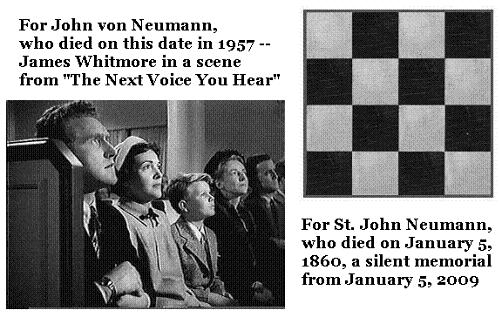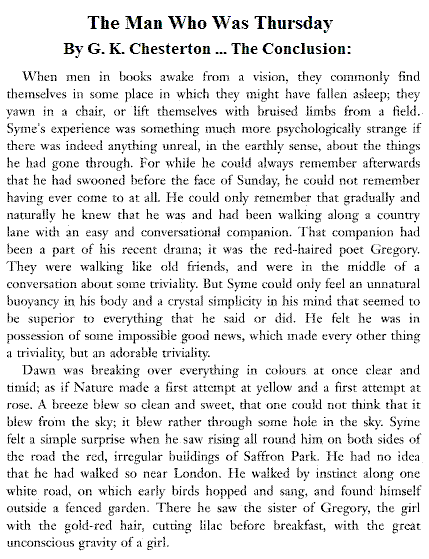Annals of Fiction:
Sunday, April 12, 2009 3:09 AM
Easter Egg:
Is God, continued
Dialogue from the classic film Forbidden Planet--
"... Which makes it a gilt-edged priority that one of us gets into that Krell lab and takes that brain boost."
-- Taken from a video (5:18-5:24 of 6:09) at David Lavery's weblog in the entry of Tuesday, April 7.
(Cf. this journal on that date.)
Thanks to Professor Lavery for his detailed notes on his viewing experiences.
My own viewing recently included, on the night of Good Friday, April 10, the spiritually significant film Indiana Jones and the Kingdom of the Crystal Skull.
The mystic circle of 13 aliens at the end of that film, together with Leslie Nielsen's Forbidden Planet remark quoted above, suggests the following:
|
"The aim of Conway’s game M13
is to get the hole at the top point and all counters in order 1,2,…,12
when moving clockwise along the circle." --Lieven
Le Bruyn
 The illustration is from the weblog
entry by Lieven
Le Bruyn quoted below. The colored circles
represent 12 of the 13 projective points described below, the 13 radial strokes represent the 13 projective lines, and the
straight lines in the picture, including those that form the circle,
describe which projective points are incident with which projective
lines. The dot at top represents the "hole."
From "The Mathieu Group M12 and Conway’s M13-Game" (pdf), senior honors thesis in mathematics by Jeremy L. Martin under the supervision of Professor Noam D. Elkies, Harvard University, April 1, 1996-- "Let P3 denote the projective plane of order 3. The standard construction of P3 is to remove the zero point from a three-dimensional vector space over the field F3 and then identify each point x with -x, obtaining a space with Conway [3] proposed the following game.... Place twelve numbered counters on the points... of P3 and leave the thirteenth point... blank. (The empty point will be referred to throughout as the "hole.") Let the location of the hole be p; then a primitive move of the game consists of selecting one of the lines containing the hole, say There is an obvious characterization of a move as a permutation in S13, operating on the points of P3. By limiting our consideration to only those moves which return the hole to its starting point.... we obtain the Conway game group. This group, which we shall denote by GC, is a subgroup of the symmetric group S12 of permutations of the twelve points..., and the group operation of GC is concatenation of paths. Conway [3] stated, but did not prove explicitly, that GC is isomorphic to the Mathieu group M12. We shall subsequently verify this isomorphism. The set of all moves (including those not fixing the hole) is given the name M13 by Conway. It is important that M13 is not a group...." [3] John H. Conway, "Graphs and Groups and M13," Notes from New York Graph Theory Day XIV (1987), pp. 18–29. Another exposition (adapted to Martin's notation) by Lieven le Bruyn (see illustration above): "Conway’s puzzle M13 involves the 13 points and 13 lines of P3. On all but one point numbered counters are placed holding the numbers 1,…,12 and a move involves interchanging one counter and the 'hole' (the unique point having no counter) and interchanging the counters on the two other points of the line determined by the first two points. In the picture [above] the lines are represented by dashes around the circle in between two counters and the points lying on this line are those that connect to the dash either via a direct line or directly via the circle. In the first part we saw that the group of all reachable positions in Conway's M13 puzzle having the hole at the top position contains the sporadic simple Mathieu group M12 as a subgroup." |
For the religious significance of the circle of 13 (and the "hole"), consider Arthur and the 12 knights of the round table, et cetera.

Sunday, April 12, 2009 2:02 AM
On Holy Saturday:
From a professor's weblog:
Saturday, April 11, 2009Quote of the Day (4/11/09) (Elias Canetti Week)"The novel should not be in any hurry. Once, hurry belonged to its sphere, now the film has taken that over; measured by the film, the hasty novel must always remain inadequate. The novel, as a creature of calmer times, may carry something of that old calm into our new hastiness. It could serve many people as slow-motion; it could induce them to tarry; it could replace the empty meditations of their cults."--Elias Canetti, The Human Province Posted by David Lavery at 1:00 AM |
Friday, April 10, 2009 8:00 AM
Good Friday Meditation:
Consider the following question in a paper cited by V. S. Varadarajan:Pilate Goes
to Kindergarten
"There is a pleasantly discursive
treatment of Pontius Pilate's
unanswered question
'What is truth?'."
-- H. S. M. Coxeter, 1987,
introduction to Trudeau's
remarks on the "Story Theory"
of truth as opposed to the
"Diamond Theory" of truth in
The Non-Euclidean Revolution
E. G. Beltrametti, "Can a finite geometry describe physical space-time?" Universita degli studi di Perugia, Atti del convegno di geometria combinatoria e sue applicazioni, Perugia 1971, 57–62.
Simplifying:
"Can a finite geometry describe physical space?"
Simplifying further:
"Yes. Vide 'The Eightfold Cube.'"

Thursday, April 9, 2009 7:11 PM
Holy Thursday:
"What wine does one drink?
What bread does one eat?"
-- Wallace Stevens
Image from April 4, 2007:
the key date in The Eight
and the date that year of
Spy Wednesday:

Nature morte à l'échiquier
(les cinq sens),
"vers 1655, une narration
à valeur symbolique..."
Huile sur bois, 73 x 55 cm
Musée du Louvre, Paris
Thursday, April 9, 2009 12:12 AM
Mathematics and Narrative:
continued from
March 28, 2003

Related material:
One Ring to
Rule Them All
(Sept. 2, 2003)
and
Indiana Jones and the
Diadem of Death
(May 29, 2008)
Wednesday, April 8, 2009 8:00 PM
Annals of Religion:
Is God
"For every kind of vampire,
there is a kind of cross."
-- Thomas Pynchon in
Gravity's Rainbow
"Since 1963, when Pynchon's first novel, V., came out, the writer-- widely considered America's most important novelist since World War II-- has become an almost mythical figure,
-- Nancy Jo Sales in the November 11, 1996, issue of New York Magazine
(Click on images for their
source in past entries.)
In a Nutshell:"Plato's Ghost evokes Yeats's lament
that any claim to worldly perfection inevitably is proven wrong by the
philosopher's ghost...."
-- Princeton University Press on Plato's Ghost: The Modernist Transformation of Mathematics (by Jeremy Gray, September 2008) |
Wednesday, April 8, 2009 12:12 AM
Snow White Variations:
Good's SingularityIrving John "I.J." Good died Sunday, April 5, 2009.
The date of his death was also Palm Sunday and the day of the Academy of Country Music Awards.
Information from Wikipedia:
Good, 92, was a cryptanalyst at Bletchley Park during World War II.
"He was born as Isidore Jacob Gudak to a Jewish family in London. In his publications he was called I. J. Good. He studied mathematics at Jesus College, Cambridge, graduating in 1938. He did research work under G.H. Hardy and Besicovitch before moving to Bletchley Park in 1941 on completing his doctorate.
At Bletchley Park, he was initially in Hut 8 under the supervision of Alan Turing..."
[Related material: the death of Turing (a major fan of the Evil Queen in Snow White) and yesterday's entry]
Wikipedia states that "I. J. Good's vanity car license plate,
hinting at his spylike wartime work, was
- Let an ultraintelligent machine be defined as a machine that can far surpass all the intellectual activities of any man however clever. Since the design of machines is one of these intellectual activities, an ultraintelligent machine could design even better machines; there would then unquestionably be an 'intelligence explosion,' and the intelligence of man would be left far behind. Thus the first ultraintelligent machine is the last invention that man need ever make....
- -- Good, I. J. (1965). 'Speculations Concerning the First Ultraintelligent Machine', Advances in Computers, Vol. 6."
| "Some say the symbol of Apple Computers, the apple with a bite out of it, is a nod to Alan Turing." -- from "Alan Turing and the Apple" at Flickr, uploaded on Epiphany 2006 by guano |
Alan Turing and the Apple

Above: Composite by "guano" at Flickr
Will: Do you like apples?
Clark: Yeah.
Will: Well, I got her number.
How do you like them apples?
-- "Good Will Hunting"
Happy Spy Wednesday.
Tuesday, April 7, 2009 5:24 PM
ART WARS continued:
|
Bright Star and Dark Lady "Mexico is a solar country -- but it is also a black country, a dark country. This duality of Mexico has preoccupied me since I was a child." -- Octavio Paz, |
||
|
Bright Star
|
Amen.
|
Dark Lady
|
The same story on
May 11,
2005
with a different
dark lady:

Sunday, April 5, 2009 7:35 AM
Today's Sermon:
Sunday, April 5, 2009 5:01 AM
Annals of Fantasy--
Race to Witch Mountain
-- President Obama in Strasbourg on Friday, April 3, 2009
"George Bernard Shaw once wrote, 'Some people see things as they are and say why? I dream things that never were and say, why not?'"
-- Robert Kennedy, University of Kansas, March 18, 1968
| George
Bernard Shaw:
THE SNAKE. I can talk of many things. I am very wise. It was I who whispered the word to you that you did not know. Dead. Death. Die. EVE [shuddering] Why do you remind me of it? I forgot it when I saw your beautiful hood. You must not remind me of unhappy things. THE SERPENT. Death is not an unhappy thing when you have learnt how to conquer it. EVE. How can I conquer it? THE SERPENT. By another thing, called birth. EVE. What? [Trying to pronounce it] B-birth? THE SERPENT. Yes, birth. EVE. What is birth? THE SERPENT. The serpent never dies. Some day you shall see me come out of this beautiful skin, a new snake with a new and lovelier skin. That is birth. EVE. I have seen that. It is wonderful. THE SERPENT. If I can do that, what can I not do? I tell you I am very subtle. When you and Adam talk, I hear you say 'Why?' Always 'Why?' You see things; and you say 'Why?' But I dream things that never were; and I say 'Why not?' I made the word dead to describe my old skin that I cast when I am renewed. I call that renewal being born. EVE. Born is a beautiful word. THE SERPENT. Why not be born again and again as I am, new and beautiful every time? EVE. I! It does not happen: that is why. THE SERPENT. That is how; but it is not why. Why not? EVE. But I should not like it. It would be nice to be new again; but my old skin would lie on the ground looking just like me; and Adam would see it shrivel up and-- THE SERPENT. No. He need not. There is a second birth. EVE. A second birth? THE SERPENT. Listen. I will tell you a great secret.... |
"Listen, I tell you a mystery...."
-- Saul of Tarsus
About the People
(with apologies to
Zenna Henderson):

"We've got to stop meeting like this."
Saturday, April 4, 2009 9:48 PM
Live from New York, it's...
Los Angeles Times, April 1:
obituary for the green demon of
Joss Whedon's TV series "Angel"--

"As you read,
watch for patterns."
-- "Pattern in The Defense,"
apparently by Jeff Edmunds
Related material:
Today's previous entries
and
"Force Field of Dreams"
(which contains the
above quotation)
in this journal on
Sept. 22, 2002
Saturday, April 4, 2009 7:01 PM
ART WARS continued:
"... in some autistic enchantment,
 pure as one of Bach's
inverted canons or Euler's formula for polyhedra."
pure as one of Bach's
inverted canons or Euler's formula for polyhedra."-- George Steiner, "A Death of Kings," in The New Yorker, issue dated Sept. 7, 1968
A correspondence underlying
the Steiner system S(5,8,24)--

The Steiner here is
Jakob, not George.
 See "Pope to Pray
on
See "Pope to Pray
onAutism Sunday 2009."
See also Log24 on that
Sunday-- February 8:

Saturday, April 4, 2009 8:00 AM
Mathematics and Narrative, continued:
The Eight

Other knight figures:


Click on the SpringerLink
knight for a free copy
(pdf, 1.2 mb) of
the following paper
dealing with the geometry
underlying the R.T. Curtis
knight figures above:

Context:
Literature and Chess and
Sporadic Group References
Details:
| Adapted (for HTML) from the opening
paragraphs of the above paper, W. Jonsson's 1970 "On the Mathieu Groups
M22, M23, M24..."-- "[A]... uniqueness proof is offered here based upon a detailed knowledge of the geometric aspects of the elementary abelian group of order 16 together with a knowledge of the geometries associated with certain subgroups of its automorphism group. This construction was motivated by a question posed by D.R. Hughes and by the discussion Edge [5] (see also Conwell [4]) gives of certain isomorphisms between classical groups, namely where A8 is the alternating group on eight symbols, S6 the symmetric group on six symbols, Sp(4,2) and PSp(4,2) the symplectic and projective symplectic groups in four variables over the field GF(2) of two elements, [and] PGL, PSL and SL are the projective linear, projective special linear and special linear groups (see for example [7], Kapitel II). The symplectic group PSp(4,2) is the group of collineations of the three dimensional projective space PG(3,2) over GF(2) which commute with a fixed null polarity tau...." References 4. Conwell, George M.: The three space PG(3,2) and its group. Ann. of Math. (2) 11, 60-76 (1910). 5. Edge, W.L.: The geometry of the linear fractional group LF(4,2). Proc. London Math. Soc. (3) 4, 317-342 (1954). 7. Huppert, B.: Endliche Gruppen I. Berlin-Heidelberg-New York: Springer 1967. |
Friday, April 3, 2009 5:24 AM
Mr. Holland's Week continues:
"Lord, I remember"
-- Bob Seger
"Philosophers ponder the idea of identity: what it is to give something a name on Monday and have it respond to that name on Friday...."
-- Bernard Holland in The New York Times of Monday, May 20, 1996
Yesterday's afternoon entry cited philosopher John Holbo on chess. This, together with Holland's remark above and Monday's entries on Zizek, suggests...
(pdf, 11 pages)
In this excellent analysis,
Holbo quotes Kierkegaard:
"... the knight of faith
'has the pain of being unable to
make himself intelligible to others'"
(Kierkegaard, Fear and Trembling)
Cardinal Manning
Click on the cardinal
for a link to some remarks
related to the upcoming film
"Angels & Demons" and to
a Paris "Sein Feld."
Context: the five entries
ending at 9:26 AM
on March 10, 2009...
and, for Kierkegaard,
Diamonds Are Forever.
Thursday, April 2, 2009 8:00 PM
Annals of Philosophy:

for the late
Pope John Paul II --
Numbers from the
State of Grace:

Midrash:
Lottery Hermeneutics
Thursday, April 2, 2009 12:25 PM
Time and Chance, continued:
Hermeneutics
In memory of
physics historian
Martin J. Klein,
(June 25, 1924-
March 28, 2009)
-- No Truth Except in the Details: Essays in Honor of Martin J. Klein, introduction by A.J. Kox and Daniel Siegel, June 25, 1994
New York Times obituary dated April 1, 2009:
"Martin J. Klein, a historian of modern physics.... died Saturday [March 28, 2009] in Chapel Hill, N.C. He was 84 and lived in Chapel Hill."
Klein edited, among other things, Paul Ehrenfest: Collected Scientific Papers (publ. by North-Holland, Amsterdam, 1959).
|
"Almost every famous chess game
is a well-wrought urn
in Cleanth Brooks’ sense."
-- John Holbo,
Now We See
Wherein Lies the Pleasure
-- Vladimir Nabokov, foreword to The Defense
Wednesday, April 1, 2009 7:59 PM
Annals of Cinema:
Wednesday, April 1, 2009 5:01 PM
Annals of Literature:














